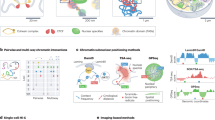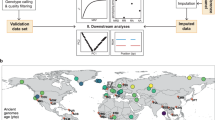Abstract
We constructed a tiling resolution array consisting of 32,433 overlapping BAC clones covering the entire human genome. This increases our ability to identify genetic alterations and their boundaries throughout the genome in a single comparative genomic hybridization (CGH) experiment. At this tiling resolution, we identified minute DNA alterations not previously reported. These alterations include microamplifications and deletions containing oncogenes, tumor-suppressor genes and new genes that may be associated with multiple tumor types. Our findings show the need to move beyond conventional marker-based genome comparison approaches, that rely on inference of continuity between interval markers. Our submegabase resolution tiling set for array CGH (SMRT array) allows comprehensive assessment of genomic integrity and thereby the identification of new genes associated with disease.
This is a preview of subscription content, access via your institution
Access options
Subscribe to this journal
Receive 12 print issues and online access
$259.00 per year
only $21.58 per issue
Buy this article
- Purchase on SpringerLink
- Instant access to full article PDF
Prices may be subject to local taxes which are calculated during checkout





Similar content being viewed by others
References
Pinkel, D. et al. High resolution analysis of DNA copy number variation using comparative genomic hybridization to microarrays. Nat. Genet. 20, 207–211 (1998).
Solinas-Toldo, S. et al. Matrix-based comparative genomic hybridization: biochips to screen for genomic imbalances. Genes Chromosomes Cancer 20, 399–407 (1997).
Kallioniemi, A. et al. Comparative genomic hybridization for molecular cytogenetic analysis of solid tumors. Science 258, 818–821 (1992).
Knuutila, S., Autio, K. & Aalto, Y. Online access to CGH data of DNA sequence copy number changes. Am. J. Pathol. 157, 689 (2000).
Forozan, F., Karhu, R., Kononen, J., Kallioniemi, A. & Kallioniemi, O.P. Genome screening by comparative genomic hybridization. Trends Genet. 13, 405–409 (1997).
Wells, D. & Levy, B. Cytogenetics in reproductive medicine: the contribution of comparative genomic hybridization (CGH). Bioessays 25, 289–300 (2003).
Snijders, A.M. et al. Assembly of microarrays for genome-wide measurement of DNA copy number. Nat. Genet. 29, 263–264 (2001).
Fiegler, H. et al. DNA microarrays for comparative genomic hybridization based on DOP-PCR amplification of BAC and PAC clones. Genes Chromosomes Cancer 36, 361–374 (2003).
Veltman, J.A. et al. High-throughput analysis of subtelomeric chromosome rearrangements by use of array-based comparative genomic hybridization. Am. J. Hum. Genet. 70, 1269–1276 (2002)
Kraus, J., Pantel, K., Pinkel, D., Albertson, D.G. & Speicher, M.R. High-resolution genomic profiling of occult micrometastatic tumor cells. Genes Chromosomes Cancer 36, 159–166 (2003).
Veltman, J.A. et al. Array-based comparative genomic hybridization for genome-wide screening of DNA copy number in bladder tumors. Cancer Res. 63, 2872–2880 (2003).
Weiss, M.M. et al. Genomic profiling of gastric cancer predicts lymph node status and survival. Oncogene 22, 1872–1879 (2003).
Garnis, C., Baldwin, C., Zhang, L., Rosin, M.P. & Lam, W.L. Use of complete coverage array CGH to define copy number alterations on chromosome 3p in oral squamous cell carcinomas. Cancer Res. 63, 8582–8585 (2003).
Wilhelm, M. et al. Array-based comparative genomic hybridization for the differential diagnosis of renal cell cancer. Cancer Res. 62, 957–960 (2002).
Bruder, C.E. et al. High resolution deletion analysis of constitutional DNA from neurofibromatosis type 2 (NF2) patients using microarray-CGH. Hum. Mol. Genet. 10, 271–282 (2001).
Garnis, C., Campbell, J., Zhang, L., Rosin, M.P. & Lam, W.L. OCGR Array, an oral cancer genomic regional array for comparative genomic hybridization analysis. Oral Oncol. (in the press).
Garnis, C. et al. Novel regions of amplification on 8q distinct from the MYC locus and frequently altered in oral dysplasia and cancer. Genes Chromosomes Cancer 39, 93–98 (2004).
Albertson, D.G. et al. Quantitative mapping of amplicon structure by array CGH identifies CYP24 as a candidate oncogene. Nat. Genet. 25, 144–146 (2000).
Denyssevych, T. et al. Establishment and comprehensive analysis of a new human transformed follicular lymphoma B cell line, Tat-1. Leukemia 16, 276–283 (2002).
Levin, N.A. et al. Identification of frequent novel genetic alterations in small cell lung carcinoma. Cancer Res. 54, 5086–5091 (1994).
Girard, L. et al. Genome-wide allelotyping of lung cancer identifies new regions of allelic loss, differences between small cell lung cancer and non-small cell lung cancer, and loci clustering. Cancer Res. 60, 4894–4906 (2000).
Quinn, L.A., Moore, G.E., Morgan, R.T. & Woods, L.K. Cell lines from human colon carcinoma with unusual cell products, double minutes, and homogeneously staining regions. Cancer Res. 39, 4914–4924 (1979).
Wessendorf, S. et al. Automated screening for genomic imbalances using matrix-based comparative genomic hybridization. Lab. Invest. 82, 47–60 (2002).
Kim, S. et al. PTEN and TNF-alpha regulation of the intestinal-specific Cdx-2 homeobox gene through a PI3K, PKB/Akt, and NF-kappaB-dependent pathway. Gastroenterology 123, 1163–1178 (2002).
Dreyling, M.H. et al. Alterations of the cyclin D1/p16–pRB pathway in mantle cell lymphoma. Cancer Res. 57, 4608–4614 (1997).
Xiu, M. et al. The transcriptional repressor HBP1 is a target of the p38 mitogen-activated protein kinase pathway in cell cycle regulation. Mol. Cell. Biol. 23, 8890–8901 (2003).
McPherson, J. et al. A physical map of the human genome. Nature 409, 934–941 (2001).
Watson, S.K. et al. Methods for high throughput validation of amplified fragment pools of BAC DNA for constructing high resolution CGH arrays. BMC Genomics 5, 6 (2004).
Acknowledgements
We thank J. Vielkind, S. Lam, D. Horsman, M. Rosin, S. Herst, K. Lonergan, S. Ralph, J. Rathmann, R. Seagraves, M. Krzywinski, P. Lansdorp, G. Bebb, J. Schein, I. Bosdet, D. Smailus, Z. Xu, C. Brown, J. Minna and A. Gazdar for their contributions. This project was supported by funds from Genome Canada/British Columbia.
Author information
Authors and Affiliations
Corresponding author
Ethics declarations
Competing interests
The authors declare no competing financial interests.
Supplementary information
Rights and permissions
About this article
Cite this article
Ishkanian, A., Malloff, C., Watson, S. et al. A tiling resolution DNA microarray with complete coverage of the human genome. Nat Genet 36, 299–303 (2004). https://doi.org/10.1038/ng1307
Received:
Accepted:
Published:
Issue date:
DOI: https://doi.org/10.1038/ng1307
This article is cited by
-
Application of genetics and biotechnology for improving medicinal plants
Planta (2019)
-
Copy number variability in Parkinson’s disease: assembling the puzzle through a systems biology approach
Human Genetics (2017)
-
A high-throughput fluorimetric microarray with enhanced fluorescence and suppressed “coffee-ring” effects for the detection of calcium ions in blood
Scientific Reports (2016)
-
“Down syndrome: an insight of the disease”
Journal of Biomedical Science (2015)
-
Novel chemiluminescent imaging microtiter plates for high-throughput detection of multiple serum biomarkers related to Down’s syndrome via soybean peroxidase as label enzyme
Analytical and Bioanalytical Chemistry (2015)



